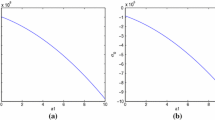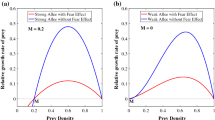Abstract
Recent field experiments on vertebrates showed that the mere presence of a predator would cause a dramatic change of prey demography. Fear of predators increases the survival probability of prey, but leads to a cost of prey reproduction. Based on the experimental findings, we propose a predator–prey model with the cost of fear and adaptive avoidance of predators. Mathematical analyses show that the fear effect can interplay with maturation delay between juvenile prey and adult prey in determining the long-term population dynamics. A positive equilibrium may lose stability with an intermediate value of delay and regain stability if the delay is large. Numerical simulations show that both strong adaptation of adult prey and the large cost of fear have destabilizing effect while large population of predators has a stabilizing effect on the predator–prey interactions. Numerical simulations also imply that adult prey demonstrates stronger anti-predator behaviors if the population of predators is larger and shows weaker anti-predator behaviors if the cost of fear is larger.



















Similar content being viewed by others
References
Abrams PA (2000) The evolution of predator–prey interactions: theory and evidence. Annu Rev Ecol Syst 31:79–105
Baer SM, Kooi BW, Kuznetsov YA, Thieme HR (2006) Multicodimensional bifurcation analysis of a basic two stage population model. SIAM J Appl Math 66:1339–1365
Beretta E, Kuang Y (2002) Geometric stability switch criteria in delay differential systems with delay dependent parameters. SIAM J Math Anal 33:1144–1165
Cooke KL, van den Driessche P, Zou X (1999) Interaction of maturation delay and nonlinear birth in population and epidemic models. J Math Biol 39:332–352
Cooke KL, Elderkin RH, Huang W (2006) Predator–prey interactions with delays due to juvenile maturation. SIAM J Appl Math 66:1050–1079
Creel S, Christianson D (2008) Relationships between direct predation and risk effects. Trends Ecol Evol 23:194–201
Creel S, Christianson D, Liley S, Winnie JA (2007) Predation risk affects reproductive physiology and demography of elk. Science 315:960–960
Cresswell W (2011) Predation in bird populations. J Ornithol 152:251–263
Faria T (2006) Asymptotic stability for delayed logistic type equations. Math Comput Model 43:433–445
Gourley SA, Kuang Y (2004) A stage structured predator–prey model and its dependence on maturation delay and death rate. J Math Biol 49:188–200
Győri I, Trofimchuk SI (2002) On the existence of rapidly oscillatory solutions in the Nicholson blowflies equation. Nonlinear Anal Theory Methods Appl 48:1033–1042
Křivan V (2007) The Lotka–Volterra predator–prey model with foraging–predation risk trade-offs. Am Nat 170:771–782
Kuang Y, So JW-H (1995) Analysis of a delayed two-stage population model with space-limited recruitment. SIAM J Appl Math 55:1675–1696
Lima SL (1998) Nonlethal effects in the ecology of predator–prey interactions. Bioscience 48:25–34
Lima SL (2009) Predators and the breeding bird: behavioural and reproductive flexibility under the risk of predation. Biol Rev 84:485–513
Liu S, Beretta E (2006) A stage-structured predator–prey model of Beddington–DeAngelis type. SIAM J Appl Math 66:1101–1129
Peacor SD, Peckarsky BL, Trussell GC, Vonesh JR (2013) Costs of predator-induced phenotypic plasticity: a graphical model for predicting the contribution of nonconsumptive and consumptive effects of predators on prey. Oecologia 171:1–10
Sheriff MJ, Krebs CJ, Boonstra R (2009) The sensitive hare: sublethal effects of predator stress on reproduction in snowshoe hares. J Anim Ecol 78:1249–1258
Svennungsen TO, Holen ØH, Leimar O (2011) Inducible defenses: continuous reaction norms or threshold traits? Am Nat 178:397–410
Shu H, Wang H, Wu J (2013) Global dynamics of Nicholson’s blowflies equation revisited: onset and termination of nonlinear oscillations. J Differ Equ 255:2565–2586
Takeuchi Y, Wang W, Nakaoka S, Iwami S (2009) Dynamical adaptation of parental care. Bull Math Biol 71:931–951
Wang W, Nakaoka S, Takeuchi Y (2008) Invest conflicts of adult predators. J Theor Biol 253:12–23
Wang X, Zanette LY, Zou X (2016) Modelling the fear effect in predator–prey interactions. J Math Biol. doi:10.1007/s00285-016-0989-1
Wei J, Li M (2005) Hopf bifurcation analysis in a delayed Nicholson blowflies equation. Nonlinear Anal Theory Methods Appl 60:1351–1367
Wirsing AJ, Ripple WJ (2011) A comparison of shark and wolf research reveals similar behavioural responses by prey. Front Ecol Environ 9:335–341
Yamamichi M, Yoshida T, Sasaki A (2011) Comparing the effects of rapid evolution and phenotypic plasticity on predator–prey dynamics. Am Nat 178:287–304
Zanette LY, White AF, Allen MC, Clinchy M (2011) Perceived predation risk reduces the number of offspring songbirds produce per year. Science 334:1398–1401
Acknowledgements
We benefitted a lot from the consultation and discussion with Dr. Liana Zanette in setting up the model, and we would like to thank Dr. Zanette for her friendly and generous help. We thank the two anonymous reviewers for their valuable suggestions and comments, which have led to a substantial improvement in the presentation of this paper.
Author information
Authors and Affiliations
Corresponding author
Additional information
Research was partially supported by the Natural Sciences and Engineering Research Council of Canada (Grant No. RGPIN-2016-04665).
Rights and permissions
About this article
Cite this article
Wang, X., Zou, X. Modeling the Fear Effect in Predator–Prey Interactions with Adaptive Avoidance of Predators. Bull Math Biol 79, 1325–1359 (2017). https://doi.org/10.1007/s11538-017-0287-0
Received:
Accepted:
Published:
Issue Date:
DOI: https://doi.org/10.1007/s11538-017-0287-0
Keywords
- Prey–predator interaction
- Fear effect
- Anti-predator response
- Maturation delay
- Equilibrium
- Stability
- Bifurcation




